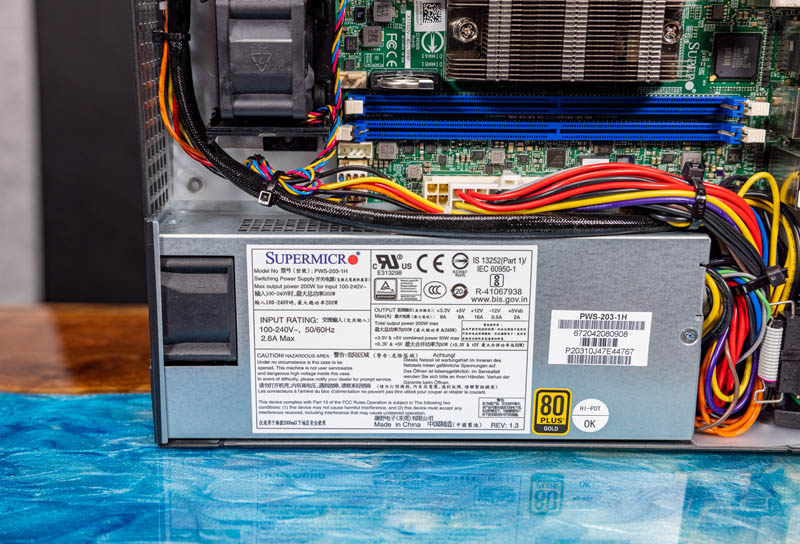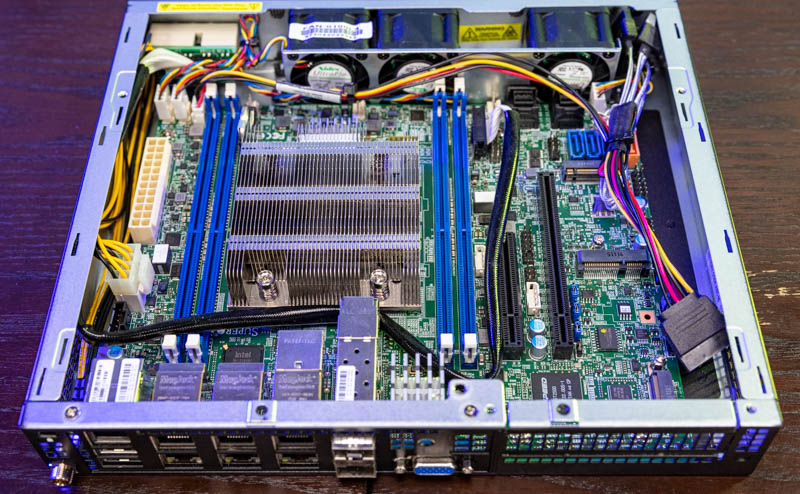Power Consumption
Here are a few key stats we recorded with the system equipped with 4x 32GB DDR4-2400 and an Intel DC S3710 400GB SSD.
- Idle: 51.3W
- 60% Load (non-AVX): 82.6W
- AVX-512 GROMACS Load: 99.28W
We held these workloads for 20 minutes in a 17.1C data center with 55% RH on 208V power. Note, these are slightly outside of where we normally take measurements and on a shorter duration interval. At the same time, we wanted to get information out as soon as possible.

We are just going to note that that noise is perhaps the weak point of this system. It is loud at boot which is acceptable. The power supply does not have a fan so it is relatively quiet. The three 1U fans are quiet enough at idle but the fans ramp under load to the point where this system should be kept in an equipment closet or somewhere that does not have a relatively low noise floor. In contrast, some systems have internal PSUs that can be noisy as can be seen above. Below we have an example where the PSU is silent and external, but we still have fans. These systems require passive heatsink airflow from the chassis, and many systems based on this motherboard can be quite noisy if they run fans at a high load.

Overall though, this is a relatively simple platform with decent power consumption and noise that can be reduced if a system is designed properly.
Final Words
For those wondering what is going on, we actually had this review written except for this section for some time. Feel free to read that as “a very long time” actually. Indeed, we even looked at the Supermicro SYS-5019D-4C-FN8TP with this motherboard and did a video on that one:
As well as the Supermicro E300-9D-4CN8TP and did a video on that as well.
What was somewhat funny is how close the two cover images are. They both focus on the networking side of things, and these lower-cost 4-core units deliver a good balance of performance and connectivity.
This motherboard and the two platforms above we now have several versions of running in our data centers. For the 1/10GbE generation, these are great, and will still be in service for us for some time. At the same time, we have started to look at the next-generation Intel Xeon Ice Lake-D and we have the new Supermicro platforms for that:
Expect to see reviews of those new platforms coming in the next few weeks.
Still, this is a motherboard that we have used in a variety of form factors, and for a few years now. As a result, it is one that we can feel comfortable recommending so long as you remember to have active chassis cooling over the passive heatsink. The one caveat now is that we may recommend the Ice Lake-D X12SDV series instead if pricing is close as there are a number of new features in the newest generation that are worthwhile.




“The power supply does not have a fan so it is relatively quiet.” Below a picture of a power supply with a fan in it.
When can we expect to see the Ice Lake-D hit the market and see a review?
FYI, I believe this particular 4 core version runs DDR4 up to 2400 instead of 2133 as stated in the article. You can see this in the manual and I also personally run this board with DDR4 2400.
@james, i believe they were referring to the chassis with the pico-psu in it, which does NOT have a fan, but you’re right it’s confusing since they show 2 different chassis.